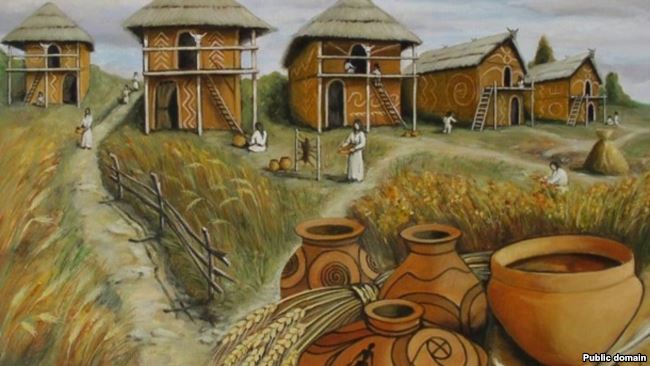Mykola Iakovyna, the Honorary President of Ukraine’s National Committee of the International Council on Monuments and Sites (ICOMOS), has said that UNESCO has full power to recognize which man-made and natural objects have universal value and merit their preservation for all humanity. Therefore Iakovyna considers the potential inclusion of the Trypillian culture, also known by the name of Kukuteni, to that registry of objects as exceptionally good news.
“Now the world will know that our lands were not wild steppe, but already 4,500 years ago they gave rise to the most refined agricultural civilization in Europe, one older than the civilizations of antiquity,” he explained.
The expert said that the Trypillians, who lived in what is today Ukrainian lands west of the Dnipro River, attained an extraordinary level of development.
“When people of my generation went to school, we learned that the Trypilians did not even have the wheel. But now archeology is correcting this misconception – they had the wheel, and they knew how to build multi-level buildings; they built huge cities with populations several times over 10,000. This was a unique civilization.”

Mykola Belenko, an employee at the National Museum of the History of Ukraine, ascertains that Ukraine needs UNESCO’s aid in the preservation of the Trypillian heritage because the state itself cannot manage this.
“Our state does not protect our historical heritage, nor does it protect our archeological artifacts. Therefore if UNESCO, such an important organization, takes up the protection of our artifacts, this can only be good for our culture. I’m not saying UNESCO is extraordinarily effective, but it won’t hurt,” he commented to Radio Svoboda.
Mykola Iakovyna remarked that although significant costs are allocated from the state budget for the preservation of artifacts, the problem is with using them reasonably. Merely a UNESCO status, he says, will not change the reality on the ground.
“The presence of any artifacts in the registry of global heritage will not call forth manna from heaven. Everything will still remains like it was, but the artifacts would now be beneath the diligent monitoring of an international organization,” the expert explained.
Iuriy Kochubey, Ukraine’s former Representative to UNESCO, recognizes that the established authority of the organization in preserving cultural artifacts, but nonetheless points out that UNESCO is not a police force, rather, it is an intergovernmental agency.
Kochubey explained UNESCO’s procedure this way:
“UNESCO can appeal to our government demanding that the government enacts its agreements which pertain to the preservation of artifacts of global significance. For this it is necessary that UNESCO appeals to our cultural figures, architects, city-planners and says, ‘Look, agreements are being violated, we beg you to get involved.’ UNESCO cannot give commands, but it can turn the government’s attention to what is happening, let’s say, in Kyiv regarding the support of different zones and artifacts.”
The disregard of UNESCO’s recommendations hurts a country’s image, especially for tourists, and particularly if objects are removed from the World Heritage List.
Ukraine is already in the risk zone. Earlier, Tamara Mazur, Ukraine’s Vice Minister for Culture, reported that Kyiv’s Saint Sophia Cathedral and Monastery of the Caves may be included in a list of threatened objects of cultural heritage. If that happens, Mykola Iakovyna affirmed, it would be a “national shame” for Ukraine.


“In the last session of the UNESCO World Heritage Committee we received a red card, and this has already happened repeatedly, because of the state of the historical sites of Kyiv – namely, the Saint Sophia Cathedral with the adjacent buildings of the Monastery of the Caves,” Iakovyna complained, referring to Ukraine’s major UNESCO objects in Kyiv.
Yet the problems go beyond artifacts in Kyiv – a great number of World Heritage List objects, for which the Ukrainian state is responsible, are located in Crimea and have fallen under Russian occupation.
“Literally, two weeks ago, at the 202nd Plenary session of the UNESCO council, Ukraine maintained a clear position, and this went into the report of the General Directory of UNESCO: we insist on a system of continual monitoring of the entire situation in Crimea including the peninsula’s cultural heritage. We hope, on November 10, when UNESCO’s general conference begins, that we will acquire such a system,” Iakovyna said.
Approximately 15,000 artifacts, of both local and national significance, have been lost under Russian occupation in Crimea and eastern Ukraine. Experts are unable to assess their cumulative monetary value. “We will figure out this confusing arithmetic when we present evidence to the aggressor-state as part of a Tribunal at The Hague. And I hope this will happen soon,” Iakovyna predicted. In the meantime, however, he provided tourism statistics: prior to its annexation by Russia in 2014, every other excursion in Ukraine was conducted at tourist attractions on the Crimean peninsula.
Oleh Shamshur, Ukraine’s previous acting representative to UNESCO, explained that UNESCO is working on a mechanism for the direct monitoring of the conditions of artifacts of global significance in occupied Crimea.




